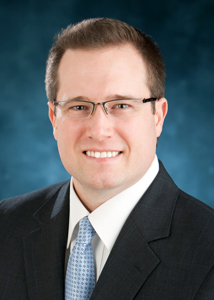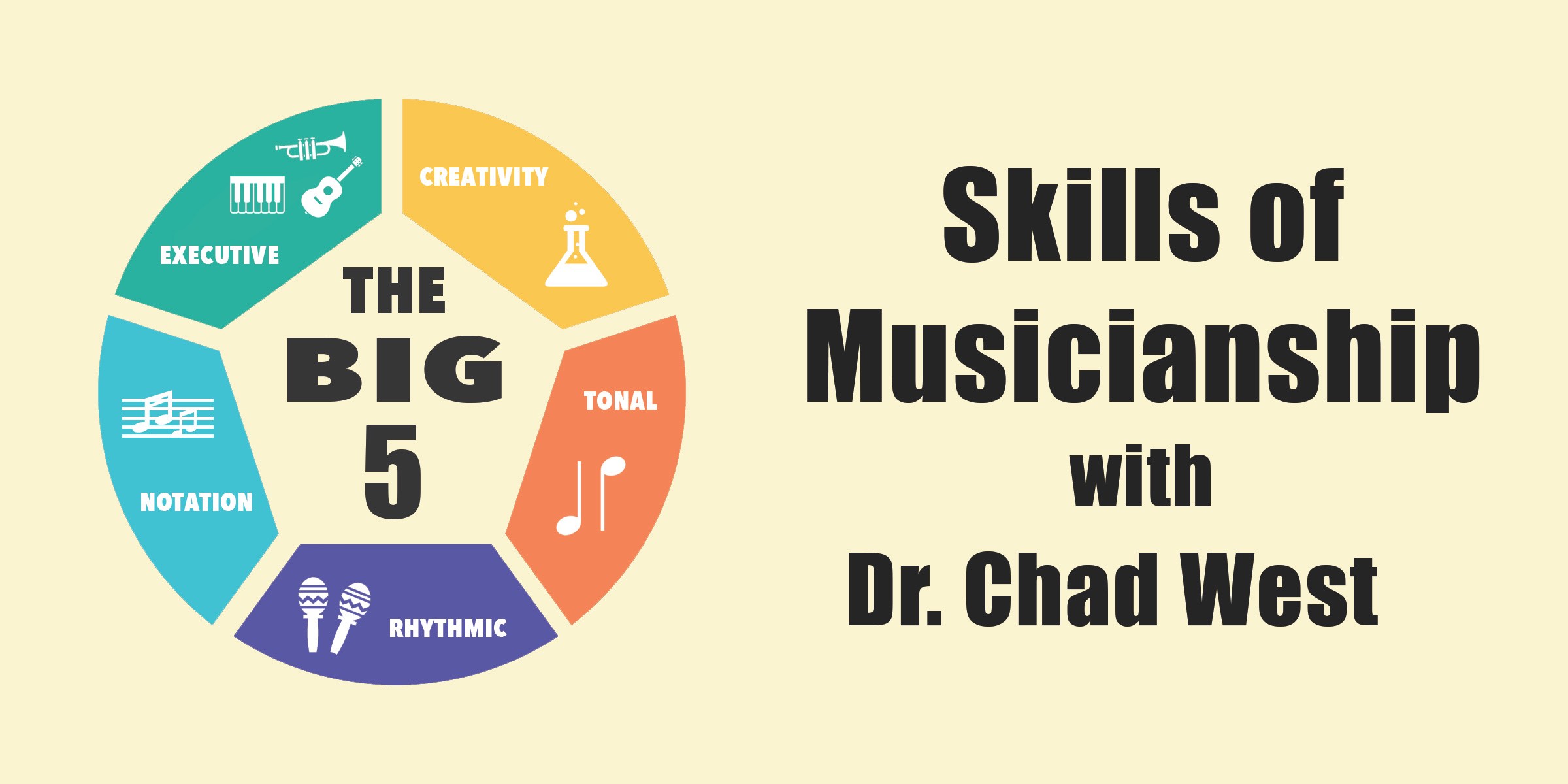Becoming a musician just means you learn to play an instrument, right? Not quite… In fact, as music learners quickly discover, there are a wide variety of skills involved in being a capable and versatile musician. These go far beyond just knowing the movements to make your instrument play the right notes.
Dr. Chad West is an Associate Professor and Chair of Music Education at Ithaca College and frequently presents at music education conferences. He is a leading expert on the core musicianship skills mentioned above, and has codified them as five distinct skill groups to be learned:
- Executive
- Notation
- Rhythmic
- Tonal
- Creativity
The “executive” skills are the ones we think of first—how to play a physical musical instrument—and the “notation” skills are the ones traditionally taught as part of music theory and sheet music reading. These Dr. West classes as the “external” skills of musicianship. However it is the other three, the “internal” skills, which are sometimes overlooked: having a good sense of rhythm, understanding melodies and harmony, and being creative with your own musical ideas.
The approach recommended by Dr. West, covering all of these “Big 5” areas, is one which aligns well with what we teach here at Easy Ear Training and at Musical U: that the instrument and music theory skills are essential, but you must also dedicate time and practice to the third component: your “inner skills” of musicality. These are the skills which allow you to bring music to life in your own way and truly feel ownership and mastery of the notes you play in an intimate way.
After reading about Dr. West’s work on the SmartMusic blog recently we were very keen to talk with him about his fascinating research and find out more about how he views modern musicality training.
Q: Thank you, Dr. West, for joining us today, and welcome to EasyEarTraining.com!
Your concept of approaching music education in terms of the “Big 5” (rhythmic, tonal, notation, creativity and executive skills) clearly and concisely captures the various aspects of musicianship.
However, I think it’s fair to say that traditional music education – from personal instrument lessons and exams, to school music classes in the US and UK, to online courses and video tutorials – tend to be very lop-sided when viewed in this framework, focusing heavily on the executive skills, and to some extent the notation.
Why do you think that is? Why has “inner musicianship” been so neglected in 20th century music education?
 Many of us, when we refer to “traditional” music education, are really talking about school music education in the latter part of the 20th century and today. If we go back a little further, we recall that “traditional” music education was very much in line with developing internal musicianship skills.
Many of us, when we refer to “traditional” music education, are really talking about school music education in the latter part of the 20th century and today. If we go back a little further, we recall that “traditional” music education was very much in line with developing internal musicianship skills.
Just think of the transmission process before music became heavily schoolified: music was passed on aurally in communities, homes, and churches. This form of (traditional) music education was much less heavily focused on notation and executive skills than in schools today. Instead of referring to “traditional” music education in this context, I tend to refer to it as “current practice.” If one were to say that “current practice tends to focus heavily on executive skills and notation,” then I would agree.
Why do I think that current practice tends to focus heavily on these skills, often at the expense of developing internal musicianship skills? I think it is in part because notation and technique are easier to teach and more quantifiable to assess. It is difficult to know if a student is audiating, but it is very easy to see if they can not interpret notation or manipulate their instrument. We need to remember, however, that just because something is observable and quantifiable, does not necessarily make it the most important. As the old saying goes, “Not everything that can be counted counts, and not everything that counts can be counted.”
Why has internal musicianship been so neglected in 20th century music education? It is actually not neglected in the very best elementary general music classrooms. Just think of music teachers that are skilled in Kodály, Music Learning Theory, Dalcroze, Orff, and Suzuki.

In these classrooms, you see children moving, singing, chanting, listening, and improvising. The emphasis is not so much on executive skills such as vocal production or playing technique, but on basic musicianship skills such as audiating, matching pitch, keeping steady time, and creating. These teachers know that when students have highly developed internal musicianship skills (often referred to as “readiness skills”), they are much more successful at manipulating their instruments and bringing meaning to notation.
As a young band director, I remember being appalled that my middle school students were coming to me not knowing much about notation. I thought, “what are they doing in elementary general music if not learning the basics of notation?”
After a few years, I realized that they were coming to me with something much more valuable: the internal musicianship skills that made my job as a band director much easier. If students could audiate, match pitch, keep steady time, and have a musical thought that was not dictated to them, then I could be free to develop their technique and notation abilities.
Unfortunately, this is the trap that some secondary ensemble directors fall into – assuming that students come to them with these readiness skills and failing to continue their development past the elementary general experience. That was the point of my “Big 5” article: to remind ensemble directors that developing students’ internal instruments (tonal, rhythmic, and creative skills) is as much our job as developing students’ external instruments (executive skills and notation).
Audiation is a term coined by Edwin Gordon and is used to refer to hearing and comprehending in one’s mind sounds that are not physically present. A simple example of this would be when you get a tune “stuck in your head.” Another example would be when you hear a I-IV-V7 progression and then anticipate in your mind the resolution to the I chord. Another example would be where you hear the first half of a familiar musical phrase and then, in your mind, hear an alternate ending. These are all examples of audiating.
When students are not hearing pitches in their mind before they play them, not feeling time in their body as the music unfolds, and are not generating expressive musical ideas in relation to the sounds around them, then they are not being musical; they are simply being mechanical. As music teachers, we want to develop internal musicianship, not just external mechanics.
”Without audiation, students are simply pushing buttons as they decode dots on a page.”
When students aurally recognize missed notes, feel when they are rushing or dragging, and have musical ideas apart from that which is dictated to them, then they are functioning as musicians. Without audiation, students are simply pushing buttons as they decode dots on a page.
I would say that Music Learning Theory (MLT) has completely changed how I approach music education. For me, it was realizing the importance of audiation. However, MLT is much more in depth than I apply it in my teaching—for me, it is just about getting kids singing, moving, chanting, and creating.
Someone who is certified in MLT will probably look at my “Big 5” article and think that it is a cute MLT-friendly piece, but would probably not view it as a formula or approach to implementing MLT in the classroom. For readers who are interested in learning about MLT, I encourage them to attend certification workshops through the Gordon Institute of Music Learning.
Yes and no. On the one hand, we need to acknowledge that it is no longer necessary to know theory or how to play an acoustic instrument to be musical. One can have an entirely satisfying musical career (professional or amateur) without these skills. Just think of all of the popular music stars that perform beautifully whether or not they read notation. Think of all the bedroom guitar players, fiddling groups, world music groups and garage bands—notation is not a requirement to create music; it is a requirement to create “school music.”
”Notation is not a requirement to create music; it is a requirement to create ‘school music.’”
We as a profession should consider whether notation is a tool that enables people to be more musical or a barrier that separates us from the rest of the musical world—I tend to think it is increasingly leaning toward the latter. As for playing a “traditional” instrument, we also need to acknowledge that this too is not a requirement for being musical. We no longer live in a society where the only way to produce music is by way of the voice or an acoustic instrument and school music education needs to acknowledge this reality and embrace it. With all of the composition programs such as GarageBand, human beings can produce music without an “instrument.”
 Or perhaps it would be more accurate to acknowledge that we are seeing the rise of a new type of instrument: the computer, the iPad, the smart phone. We can stick our heads in the sand, dismiss these instruments as not “real” instruments, and watch school music education widen the gap with music in society, or we can reinvent ourselves and usher in a more socially relevant model of school music education that embraces these new ways of being musical.
Or perhaps it would be more accurate to acknowledge that we are seeing the rise of a new type of instrument: the computer, the iPad, the smart phone. We can stick our heads in the sand, dismiss these instruments as not “real” instruments, and watch school music education widen the gap with music in society, or we can reinvent ourselves and usher in a more socially relevant model of school music education that embraces these new ways of being musical.
On the other hand, we also need to recognize the benefits of music theory and playing a “traditional” instrument. Just because we live in the 21st century does not mean that we don’t study history. Just because we have calculators does not mean we no longer learn to compute math equations. That we have TV does not diminish the importance of literature, and so on. What do theory and traditional instruments offer that can not be found with new forms of transmission and new ways of producing music? That is the question the profession needs to answer. The answer to that question should inform what we hold on to while embracing the new.
 Honestly, I think that many online tutorials and so-called “informal” music education approaches are more adept at developing internal musicianship skills than are many of our schoolified versions of music instruction (and this is from a guy who makes his living as a “traditional” music educator).
Honestly, I think that many online tutorials and so-called “informal” music education approaches are more adept at developing internal musicianship skills than are many of our schoolified versions of music instruction (and this is from a guy who makes his living as a “traditional” music educator).
The typical YouTube tutorial or other “informal” approach to learning to perform music often starts with the holistic approach of making real music.
School music, on the other hand, often takes a much more atomistic approach, often starting with notation and “whole note / whole rest” exercises that bear no semblance to music. It thus becomes an “exercise” rather than an art, a chore rather than a pleasure, and a mechanic to be mastered rather than an expression to be conveyed.
Having said that, for those wishing to develop internal musicianship skills in any setting, YouTube tutorial or school music education, I would suggest doing these things:
- Singing
- Moving to the beat
- Creating rhythms
- Creating melodies
- Listening to lots of music, and
- Singing lots of tunes.
For beginners it is just about singing, moving, and creating. For more advanced musicians, I would recommend the following:
- Learning tunes by ear without notation
- Transcribing melodies, harmonies, and rhythms by listening to them over and over
- Creating alternate endings to familiar tunes in different keys and modes
- Taking a familiar tune and recreating it in a different style, and
- Creating new tunes completely from scratch.
If you were inspired by this interview don’t hesitate to take the next steps to broaden your own musicianship. Below are some free resources you can use to explore next steps in each of the directions Dr. West suggests.
Learn more about:
- How to sing
- Getting a good sense of rhythm
- Writing your own music
- Transcribing music and melodic dictation
- Listening actively to music you hear
- Understanding different styles of music







